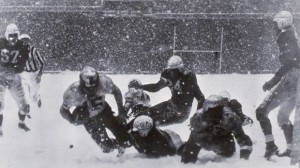On Thursday, I looked at a measure of passing efficiency and gray ink: where a first place finish rewards a player with 10 points, a second-place finish 9 points, a third-place finish 8 points, and so on. Today, I’m going to do the same thing but with rushing yards, so a rushing crown is worth 10 points, a runner-up title is worth 9 points, and so on. You can read a few twists in this footnote. [1]I want to give more credit to seasons where there were more teams. So when Kareem Hunt led the 32-team NFL last season, that was worth 10 points. What about when Pug Manders led the 9-team NFL in … Continue reading
Let’s use Barry Sanders as an example. In four seasons, he led the NFL in rushing (+40 points), and in three other seasons, he was the runner up (+27 points). He also had two seasons where he ranked 4th in rushing yards (+14) and one season where he ranked 5th (+6), for a total of 87 points. Using the pro-rated method explained in the footnote, since there were fewer than 32 teams during his career, Sanders actually gets credit for 82.7 points. That is still the most of any player in history: [continue reading…]
References
| ↑1 | I want to give more credit to seasons where there were more teams. So when Kareem Hunt led the 32-team NFL last season, that was worth 10 points. What about when Pug Manders led the 9-team NFL in 1941? That feels less meaningful, and that is especially true when comparing a 9th-place finish in 2017 to a 9th-place finish in 1941. One option is to take the number of points — say, 10 — and divided it (32/X), with X being the number of teams in the league. So if there are 9 teams, you would take 10 and divide it by 3.55, and get 2.8 points. That feels too extreme to me: it would make a first-place finish in a 9-team league less valuable than an 8th-place finish in a 32-team league. So do I use 10 points or 2.8 points… or do I split the baby? Well, that’s what I did: I averaged those two numbers to get 6.4 points, equal to a 4th- or 5th-place finish today. I was comfortable with that result, but your mileage may vary.
Other thoughts: I combined all AFL and AAFC seasons. Probably not ideal, but it was the quickest/simplest thing to do. |
|---|


